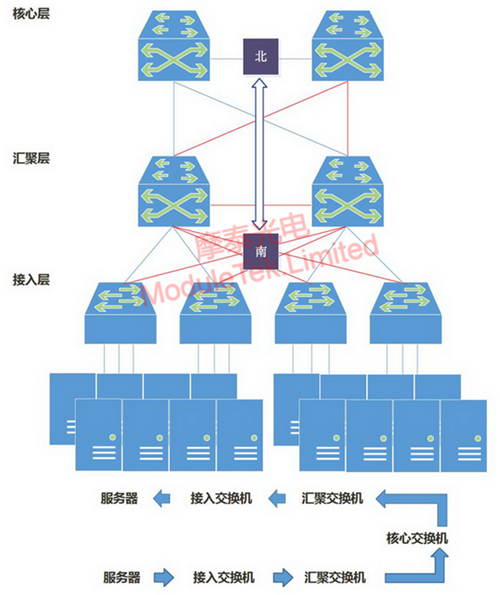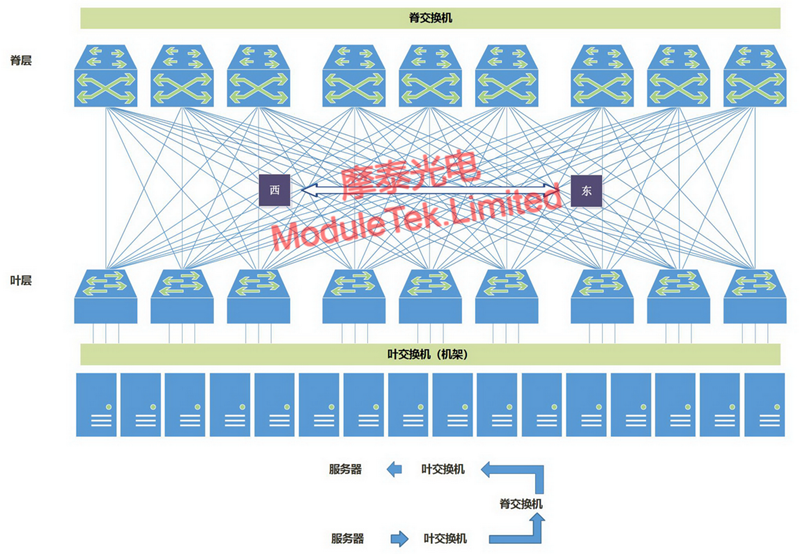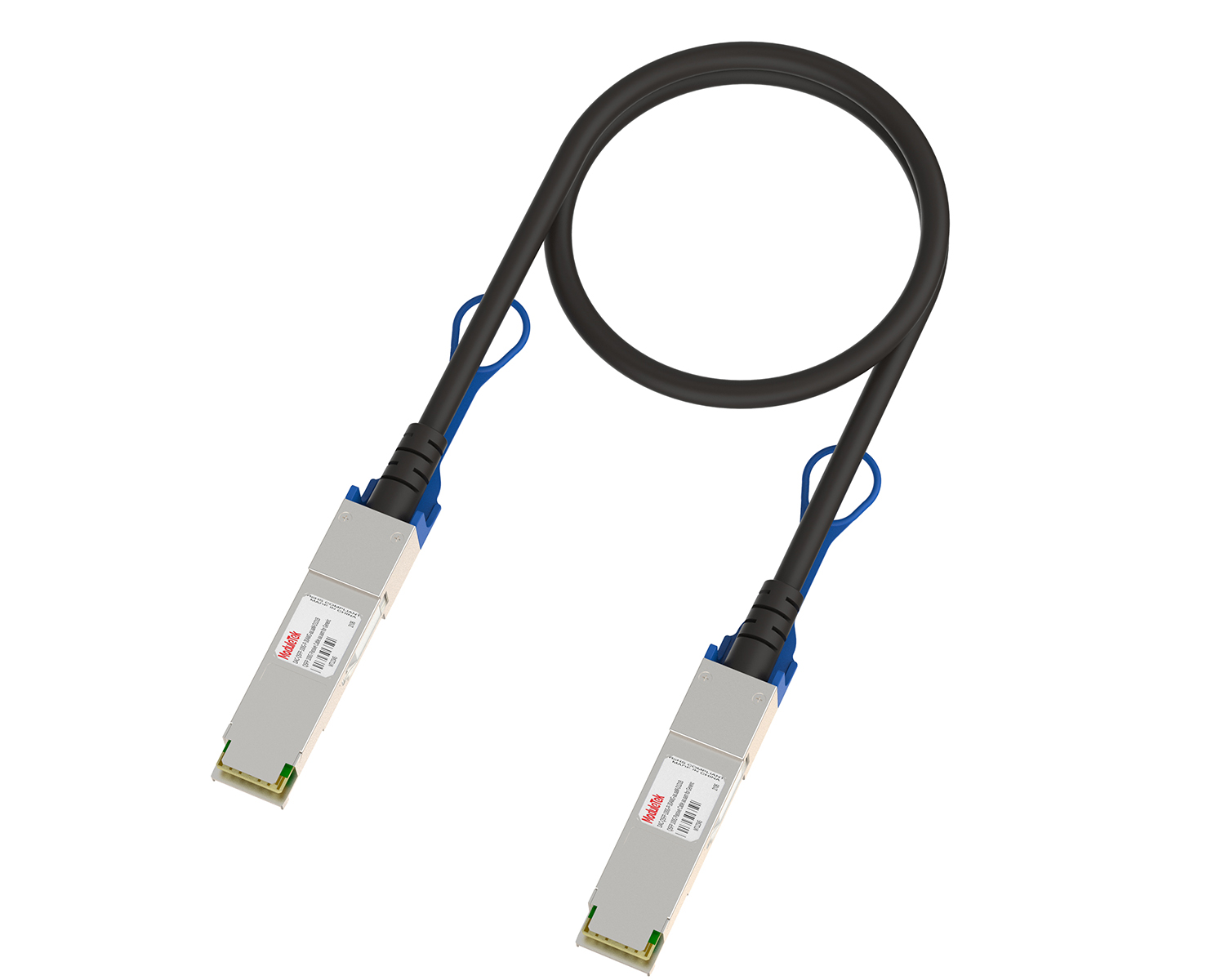New data center network architecture aransforms to "Leaf Ridge Architecture"
Time: 2022-05-24
In recent years, with the booming development of the Internet, especially the mobile Internet, applications such as big data, mobile payment, cloud storage, video media, car networking, etc., have put forward higher requirements for high-speed access to data centers, high-performance computing, massive data storage, and flexible migration of services, etc. Therefore, major Internet and IDC enterprises have successively built a high-performance, highly reliable, and flexible migration large Layer 2 network in their data centers. Therefore, major Internet and IDC companies have been building a high-performance, highly reliable, flexible migration of large two-tier network in the data center.
The traditional three-tier architecture consists of the core layer, aggregation layer and access layer, but the architecture has a prominent technical contradiction, both reliability and link utilization of the contradiction, the architecture exists in the multi-device multipath redundancy, in order to avoid the formation of loops and broadcast storms, STP protocol is enabled, which leads to a serious lack of efficiency in the utilization of the link.
Another shortcoming of this architecture is that it was originally designed mainly for south-north traffic, although it also supports east-west traffic, but there are obvious shortcomings, as shown in Figure 1, in the east-west traffic, the transmission path is access-aggregation-core-aggregation-access, which is not only a waste of resources of the core switch, multi-layer forwarding also greatly increases the delay, and the packet forwarding path has different hop counts, which leads to inconsistent packet forwarding, further affecting the response time of end-user access.

Figure 1 Traditional three-tier architecture
Therefore, in essence, the traditional three-tier architecture just to ensure that the transmission backup, data flow direction of the change makes a certain degree of not adapting to the data center network requirements. The emergence of leaf ridge network architecture and related protocols is a good solution to the shortcomings of the traditional three-tier network architecture, which constitutes a large two-tier network that better meets the needs of data center cloud computing and virtualization technology for network performance and flexible migration of services.
The leaf-ridge network architecture consists of a leaf layer (leaf layer) and a spine layer (spine layer). The leaf switch acts as an access switch to connect each server, storage and other devices, and the spine switch acts as the backbone layer responsible for routing and forwarding. In this architecture, each leaf layer switch is connected to each spine layer switch to form a fully interconnected topology. As in Figure 2:

Figure 2 Leaf-ridge network architecture
The advantages of the leaf-ridge network architecture are obvious:
⦁ First, low latency:
The traffic of servers located on different leaf switches always needs to be forwarded only once through a ridge switch to reach the leaf switch where the target server is located, so that the packets have equal-length paths, the latency becomes predictable, and the number of forwarding times is greatly reduced, thus reducing the latency.
⦁ Second, high efficiency:
Load balancing through ECMP dynamically selects multiple paths for communication, compared to the STP protocol used on the Layer 2 network can better utilize multiple links for traffic transmission, greatly increasing the efficiency.
⦁ Third, high scalability:
As different leaf switches in the same domain provide the same path and delay access, so that this large Layer 2 network services can be flexibly migrated between different also switches, when the bandwidth is insufficient, increase the number of ridge switches, which can horizontally expand the bandwidth. When the number of servers increases, increasing the number of ridge switches can also expand the data center scale. It is more conducive to the application of cloud computing and virtualization.
⦁ Fourth, low requirements:
North-south traffic, which can go out from the leaf nodes, can also go out from the ridge nodes. East-west traffic, distributed over multiple links, can greatly reduce the expensive demand for high-bandwidth, high-performance switches.
⦁ Fifth, more reliable:
Traditional networks use the STP protocol, which re-converges when a device fails, affecting network performance or even failure. The TRILL protocol (Transparent Interconnection Protocol for Multiple Links) is used in the leaf ridge architecture, so when a device fails, it does not need to re-converge, and the traffic continues to pass through other normal paths, with network connectivity unaffected, and bandwidth reduced only by the bandwidth of a single path, with a negligible impact on performance.
The current data traffic between data centers is greatly increased, and the leaf ridge architecture has excellent performance in data transmission between IDCs. Deployed according to a reasonable bandwidth ratio of no more than 3:1 between leaf ridge switches, the architecture's demand for optical modules is increased by at least 5 times compared to traditional architectures, greatly increasing the use of optical modules and patch cords. As Table 1: (data compiled from publicly available information)
Table 1 Comparison of the demand for optical modules between leaf ridge architecture and traditional architecture
|
Data Center
|
Architecture
|
Number of Optical Modules
|
||
|
10G
|
40G
|
100G
|
||
|
960 Servers Small Data Center
|
Traditional Architecture
|
2000
|
16
|
4
|
|
Leaf Ridge Architecture
|
1920
|
160
|
16
|
|
|
1000-cabinet medium to large data center
|
Traditional Architecture
|
128000
|
160
|
8
|
|
Leaf Ridge Architecture
|
120000
|
4800
|
32
|
|
We can provide a full range of 10G, 25G, 40G, 100G cost-effective solutions for the leaf ridge network architecture, welcome to call us at any time.
Moduletek Limited is at your service.
If you have any questions about the above content, you can contact us by Email : web@moduletek.com

 40G/100G Optical Transceivers
40G/100G Optical Transceivers 10G/25G Optical Transceivers
10G/25G Optical Transceivers 155M/622M/2.5G Optical Transceivers
155M/622M/2.5G Optical Transceivers 100M/1G Optical Transceivers
100M/1G Optical Transceivers FC 16G/32G Optical Transceivers
FC 16G/32G Optical Transceivers CWDM/DWDM Optical Transceivers
CWDM/DWDM Optical Transceivers 100M/1G/10G Coppers
100M/1G/10G Coppers Active Cable AOC
Active Cable AOC Direct Attach Cable DAC
Direct Attach Cable DAC Regular/MTP-MPO Fiber Patch Cords
Regular/MTP-MPO Fiber Patch Cords MT2011
MT2011 MT2010
MT2010 CodingBox
CodingBox






